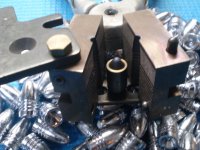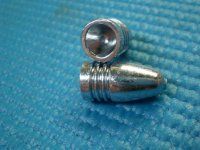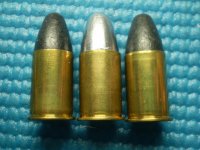Texas Star
US Veteran
I'm interested in the strength of the guns, as a buyer might be in WW I. If one could select the strongest DA .455, I wouldn't be surprised if it was the Colt New Service, with heat-treated cylinders a good while before S&W finally added that feature. US M-1917's were heat-treated, but only because the govt. required that. The .455 guns were not, and one wants to remember that in using modern .45 ACP and .45 Colt ammo in conversions.
But both the TL and the Second Model seem to have been approved for fring all .455, inc. the more powerful .455 Colt and .455 MK I, and .476.
In 1913, Webley widened the cylinder of the MK V to make it safer with smokeless loads. This was the primary difference between MK IV and V .455's.
I think that all Colt, Webley (after 1913), and S&W .455's made for smokeless powder are safe with factory loaded .455 Colt and .476 loads. It's only when handloaders try to heat up those cartridges that one may get in trouble with higher pressures.
Is that the conclusion of our experts ?
Back when they were new or soon after, I'd be trying to load my .455 with comercial Canadian or USA made .455 Colt ammo. The added velocity would be welcome in that mild cartridge, if still not quite up to .45 Colt power. However, it comes very close to US Govt. loaded .45 Colt or .45 S&W, for the Schofield.
If memory serves, the .45 Schofield and US-loaded .45 Colt used a 230 grain bullet at a nominal 725 FPS with 28 grains of black powder. The .455 Colt gave 750 FPS with a 265 grain bullet. British loaded .455 MK I gave .455 Colt stats. The shorter .455 MK II dropped velocity to 620 FPS. And many lots of ammo did not reach over 600 FPS.
Bear in mind that US Army M-1909 .45 Colt cases had a wider rim, but identical ballistics to the earlier .45 Schofield power. Apparently, the Army felt that enough for fighting fanatic tribesmen in the Philippines, although the .45 ACP, adopted in 1911, raised velocity by about 100 FPS.
But both the TL and the Second Model seem to have been approved for fring all .455, inc. the more powerful .455 Colt and .455 MK I, and .476.
In 1913, Webley widened the cylinder of the MK V to make it safer with smokeless loads. This was the primary difference between MK IV and V .455's.
I think that all Colt, Webley (after 1913), and S&W .455's made for smokeless powder are safe with factory loaded .455 Colt and .476 loads. It's only when handloaders try to heat up those cartridges that one may get in trouble with higher pressures.
Is that the conclusion of our experts ?
Back when they were new or soon after, I'd be trying to load my .455 with comercial Canadian or USA made .455 Colt ammo. The added velocity would be welcome in that mild cartridge, if still not quite up to .45 Colt power. However, it comes very close to US Govt. loaded .45 Colt or .45 S&W, for the Schofield.
If memory serves, the .45 Schofield and US-loaded .45 Colt used a 230 grain bullet at a nominal 725 FPS with 28 grains of black powder. The .455 Colt gave 750 FPS with a 265 grain bullet. British loaded .455 MK I gave .455 Colt stats. The shorter .455 MK II dropped velocity to 620 FPS. And many lots of ammo did not reach over 600 FPS.
Bear in mind that US Army M-1909 .45 Colt cases had a wider rim, but identical ballistics to the earlier .45 Schofield power. Apparently, the Army felt that enough for fighting fanatic tribesmen in the Philippines, although the .45 ACP, adopted in 1911, raised velocity by about 100 FPS.
Last edited:



